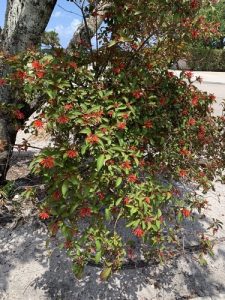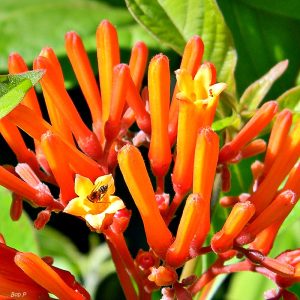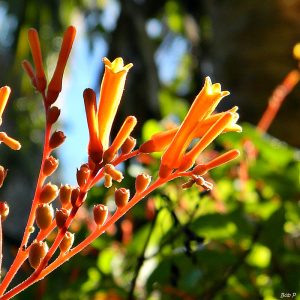The firebush (Hamelia patens), also known as “Scarletbush” or “Firecracker Shrub” gets its name from its vibrant red and orange tubular flowers. Native to Florida, this perennial is a great addition that will add a pop of color to most any landscape. Still, it is important to keep the plant’s requirements in mind when considering it for your landscape. Let’s talk about the origins, growing conditions, and benefits of firebush.

Origins of the Firebush
Firebush naturally thrives in tropical forests, dry woodlands, and coastal areas. Historically, this tropical plant has been used in traditional medicinal practices in regions like Mexico and the Caribbean. Its leaves and sap are thought to have beneficial properties in teas and topical applications on the skin.
Growing Conditions and Characteristics
The firebush is resilient in USDA Hardiness Zones 9a to 11 and can reach heights of 8 to 12 feet. It prefers moist conditions, full sun, and little fertilizer. It is known to tolerate heat and drought once established. This evergreen plant can function as a screen for privacy, as it will grow up trellises or fencing and can reach a height of 15 feet with support. This firebush can be planted as a standalone bush, hedge, or in mixed borders. With full sun, the firebush blooms throughout most of the year, with peak flowering from spring to fall. However, it will tolerate shade. Its flowers attract and support all kinds of pollinators from butterflies to hummingbirds.

Why Plant Native Species?
While native and non-invasive-exotic plants contribute positively to local ecosystems, invasive-exotic species threaten native flora and disrupt ecological balance. In Florida, invasive species such as Mexican petunia and Brazilian peppertree endanger native habitats, which is why it is important to choose suitable plants for a landscape. To learn more about invasive plants, click here.

Conclusion
Choosing native plants like firebush supports Central Florida’s local ecology by providing food and habitat for native wildlife. These plants are naturally adapted to the region’s climate and soil, requiring less fertilizer and maintenance compared to non-native species. Firebush’s nectar-rich flowers are particularly attractive to butterflies and hummingbirds, essential pollinators that contribute to the biodiversity and health of local ecosystems.
Have a question?
Supervising Agent: Dr. Whitney Elmore.
Follow us!
- Exploring Florida’s Native Gems: Carolina Jessamine
- Exploring Florida’s Native Gems: The Coontie
- Exploring Florida’s Native Gems: Chickasaw Plum
 2
2
